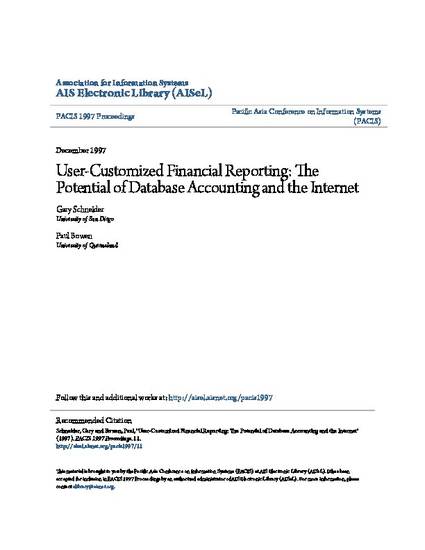
Presentation
User-Customized Financial Reporting: The Potential of Database Accounting and the Internet
Pacific Asia Conference on Information Systems (PACIS) 1997 Proceedings
(1997)
Abstract
One of the most widely-accepted ways for publicly-held firms to communicate the results of their
operations to stockholders, creditors, and other external stakeholders is to issue financial
statements. The existence of multiple acceptable, yet not reconcilable, accounting procedures
causes these financial statements to be inefficient and ineffective communication devices. Critics
of existing financial reporting standards have argued that the operation of an efficient capital
market requires a more effective dissemination of information to investors, creditors, and other
stakeholders than current accounting standards provide. Financial economists that have studied
capital markets have found that these markets may not be highly efficient, especially for smaller
firms and for firms with lightly-traded equity securities.
This paper acknowledges that events approaches to accounting that use relational databases are
becoming prevalent in larger firms. These approaches identify semantic accounting phenomena of one
sort or another and make these semantic primitives available to accounting information users in
various ways. This paper describes how current advances in inter-entity networking, such as the
Internet, and database management software, such as data warehousing, OLAP, and data mining tools,
could ultimately provide substitutes for periodic paper-based financial statements.
This paper discusses the prospects for extending database accounting to financial reporting
applications. One major barrier to the extension of these accounting approaches to financial
reporting has been the difficulty of delivering information stored in large databases to
widely-dispersed users. The Internet may provide a means for overcoming this barrier. A second
major barrier has been the need to restrict access to certain portions of the database while
providing sophisticated querying capabilities. The paper describes how the currently emerging
integration of advanced database manipulation tools with the World Wide Web (the Web) can offer
ways to overcome this second barrier. Finally, the paper notes some concerns about auditing and
controlling third-party access to firms' databases to prevent extraction of sensitive information.
Keywords
- database accounting,
- Internet,
- relational databases,
- financial reporting,
- querying capabilities,
- third-party access
Disciplines
Publication Date
Winter December 10, 1997
Location
http://aisel.aisnet.org/pacis1997/11
Citation Information
Gary Schneider and Paul Bowen. "User-Customized Financial Reporting: The Potential of Database Accounting and the Internet" Pacific Asia Conference on Information Systems (PACIS) 1997 Proceedings (1997) Available at: http://works.bepress.com/gary-schneider/51/
